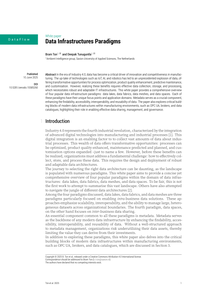De workshop heeft als doel awareness te creëren rondom metadata bij iedereen die betrokken is bij projecten waarin met data gewerkt wordt. Dit betreft zowel de onderzoeker als de datasteward en onderzoeksondersteuner.
MULTIFILE

More than 80 % of all information in an organization is unstructured, created by knowledge workers engaged in peer-to-peer networks of expertise to share knowledge across organizational boundaries. Enterprise Information Systems (EIS) do not integrate unstructured information. At best, they integrate links to unstructured information connected with structured information in their databases. The amount of unstructured information is rising quickly. Ensuring the quality of this unstructured information is difficult. It is often inaccessible, unavailable, incomplete, irrelevant, untimely, inaccurate, and/or incomprehensible. It becomes problematic to reconstruct what has happened in organizations. When used for organizational policies, decisions, products, actions and transactions, structured and unstructured information are called records. They are an entity of information, consisting out of an information object (structured or unstructured) and its metadata. They are important for organizational accountability and business process performance, for without them reconstruction of past happenings and meaningful production become an impossibility. Organization-wide management of records is not a common functionality for EIS, resulting in [1] a fragmentation in the management of records, where structured and unstructured information objects are stored in a variety of systems, unconnected with their metadata; [2] a fragmentation in metadata management, leading to a loss of contextuality because metadata are separated from their information objects; and [3] a declining quality or records, because their provenance, integrity, and preservation are in peril. Organizational accountability is based on records and their context to reconstruct the past. Because records are not controlled by EIS, they can only marginally be used for accountability. The challenge for organizational accountability is to generate trusted records, fixed and contextual information objects inseparately linked with metadata that capture context to regain evidential value and to allow for the reconstruction of the past. The research question of this paper is how to capture records and their context within EIS to regain the evidential value of records to allow for a more robust organizational accountability. To find an answer, we need to pay attention to the concept of context, on how to capture context in metadata, and how to embed and manage records in EIS.
DOCUMENT

In het begin van elk jaar geeft Harvard Business Review aan welke ideeën naar haar mening in dat jaar gaan doorbreken. Drie van de twintig heb ik er eens voor u uitgepakt. Dat zijn de cybercrimeservice-economie, de happy metadata trails en het effect van de blackberry.
DOCUMENT

De behoefte om informatie te ordenen zodat ze 'beheersbaar' wordt, resulteert vaak in een top-down aanpak zoals bibliotheeksystemen die kennen. Betrekkelijk nieuw is de bottom-up aanpak, metadatering gebaseerd op het sociale aspect van consensus. Sybilla Poortman en Gerard Bierens zoomen in op de achtergronden van folksonomy en nemen de nieuwe 'sociale' tools onder de loep met aandacht voor toepassingsmogelijkheden in de bibliotheekomgeving. En ook: folksonomy versus taxonomie, samen door één deur of ieder een eigen ingang?
DOCUMENT
Rapport van de pilot SMART Sensordata Infrastructuur (SSI). Deze pilot is uitgevoerd door docenten en studenten van de opleiding AGIS van de HAS green academy in de periode van juni t/m december 2022 in samenwerking met en met financiële steun van het DCC voor Praktijkgericht onderzoek van SURF. Dit rapport bevat de volgende op te leveren resultaten:1. Ontwerp en praktische beschrijving van algemeen toepasbare datadriven-workflow voor sensordata2. Ontwerp en praktische beschrijving van metadata-model van sensor-data, gericht op datadefinitie en datakwaliteit
DOCUMENT

Report of the project 'FAIR: geen woorden maar data' about the FAIRification of research data (in Dutch). It describes the proof of concept for implementation of the FAIR principles. The implementation is based on the resource description framework (RDF) and semantic knowledge representations using ontologies.
DOCUMENT

In the era of Industry 4.0, data has become a critical driver of innovation and competitiveness in manufacturing. The up-take of technologies such as IoT, AI, and robotics has led to an unprecedented explosion of data, offering transformative opportunities for process optimization, product quality enhancement, predictive maintenance, and customisation. However, realizing these benefits requires effective data collection, storage, and processing, which necessitates robust and adaptable IT infrastructures. This white paper provides a comprehensive overview of four popular data infrastructure paradigms: data lakes, data fabrics, data meshes, and data spaces. Each of these paradigms have their unique focus points and application domains. Metadata serves as a crucial component, enhancing the findability, accessibility, interoperability, and reusability of data. The paper also explores critical building blocks of modern data infrastructures within manufacturing environments, such as OPC UA, brokers, and data catalogues, highlighting their role in enabling effective data sharing, management, and governance.
MULTIFILE

A new bookkeeping system called Jiskefet is being developed for A Large Ion Collider Experiment (ALICE) during Long Shutdown 2, to be in production until the end of LHC Run 4 (2029). Jiskefet unifies two function- alities: a) gathering, storing and presenting metadata associated with the oper- ations of the ALICE experiment and b) tracking the asynchronous processing of the physics data. It will replace the existing ALICE Electronic Logbook and AliMonitor, allowing for a technology refresh and the inclusion of new fea- tures based on the experience collected during Run 1 and Run 2. The front end leverages web technologies much in use nowadays such as TypeScript and NodeJS and is adaptive to various clients such as tablets, mobile devices and other screens. The back end includes an OpenAPI specification based REST API and a relational database. This paper will describe the organization of the work done by various student teams who work on Jiskefet in sequential and parallel semesters and how continuity is guaranteed by using guidelines on coding, documentation and development. It will also describe the current status of the development, the initial experience in detector stand-alone commissioning setups and the future plans.
DOCUMENT
